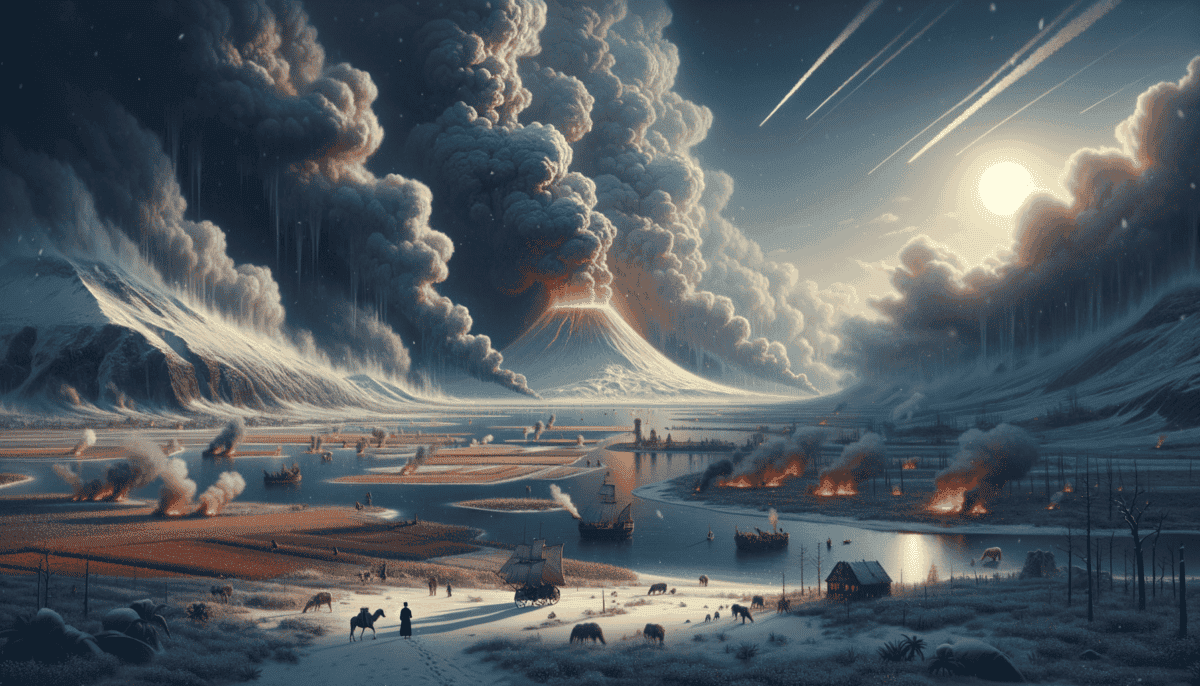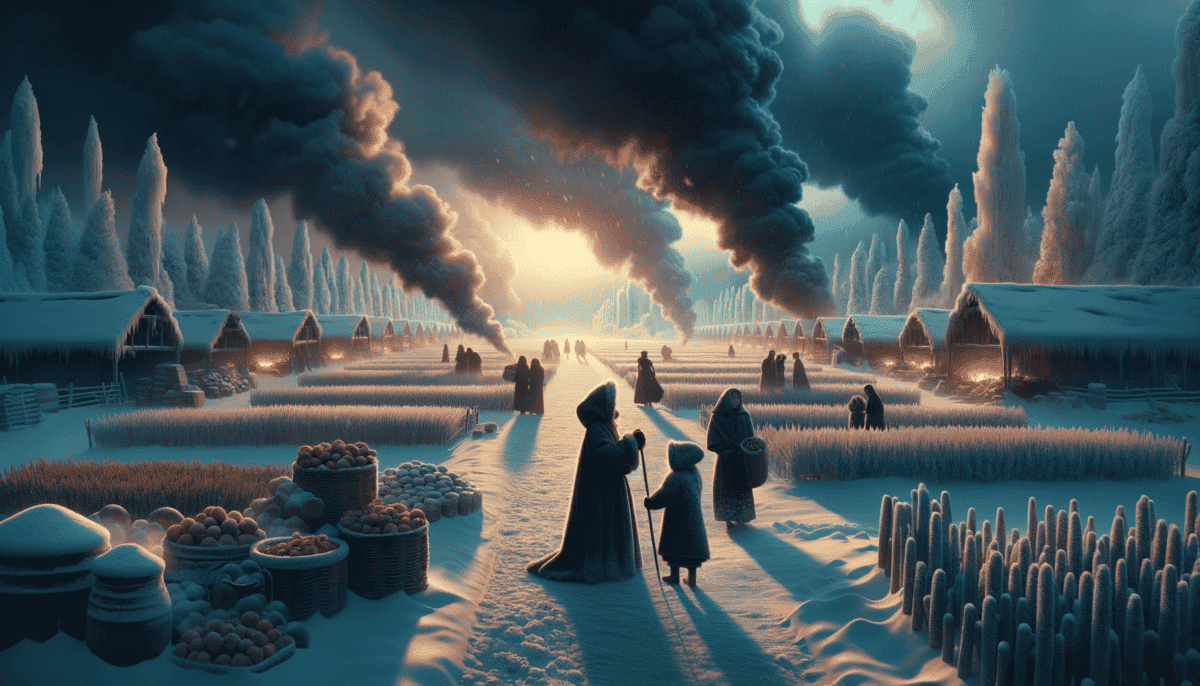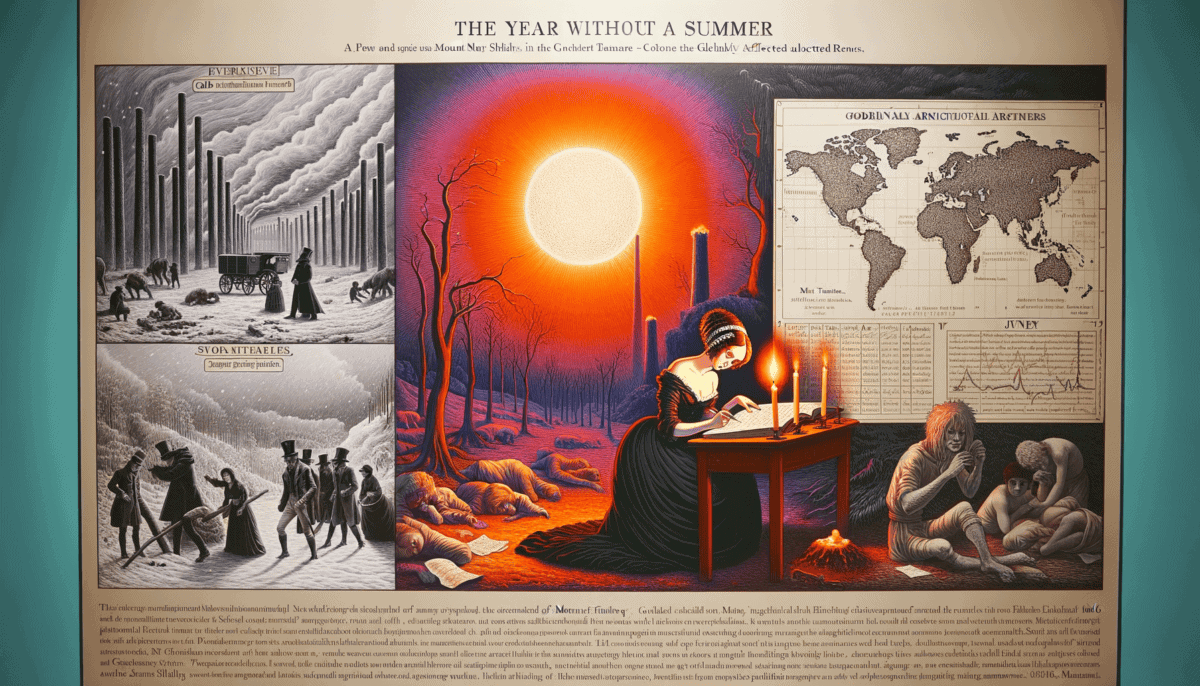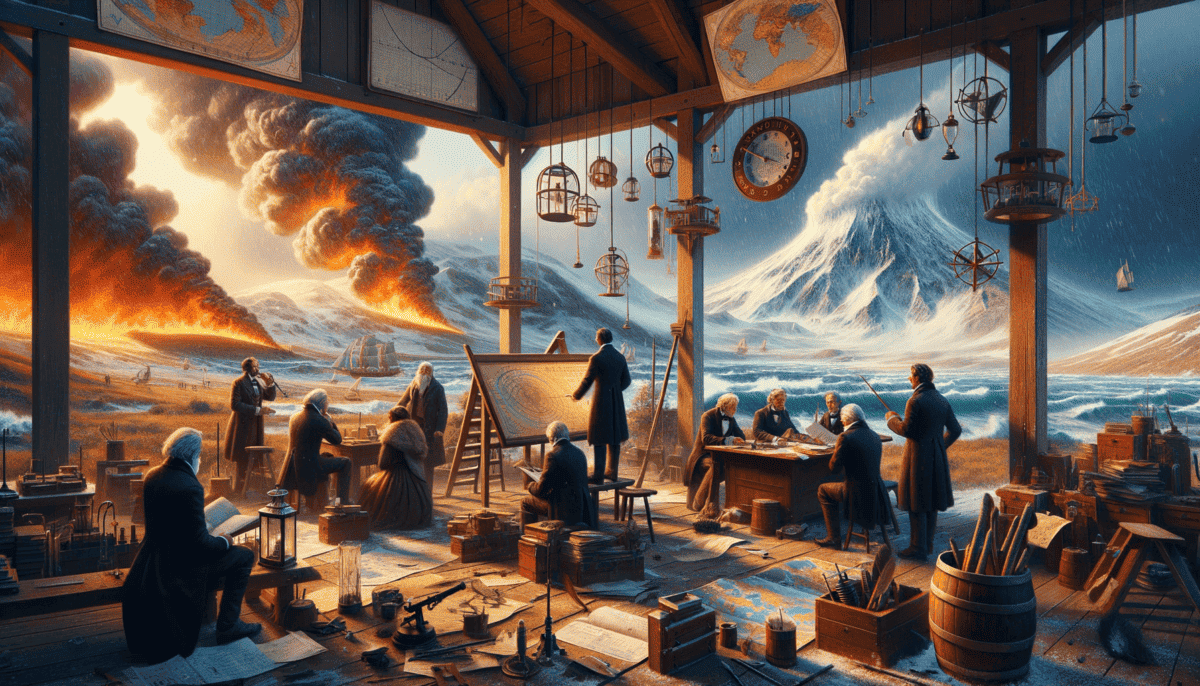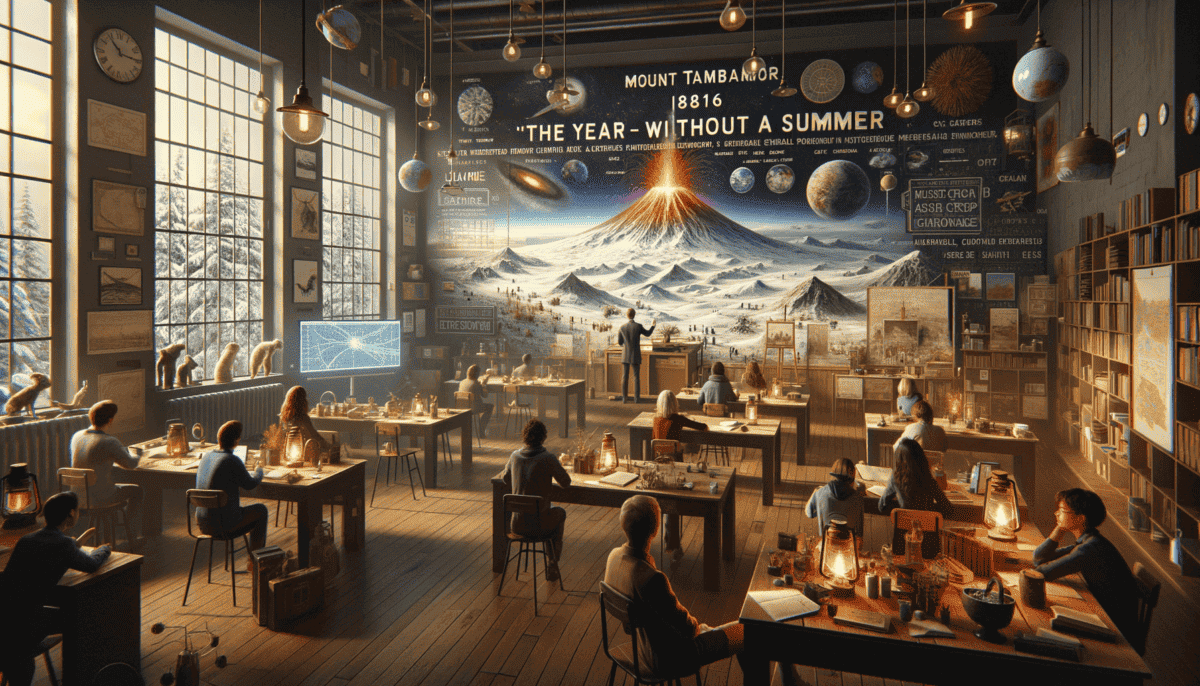The Mountain’s Awakening
The ground shook beneath little Maya's feet as she played near her village home in Indonesia. The rumbling came from Mount Tambora, a giant mountain that touched the clouds. Maya's grandmother, Nenek, rushed outside, her worried eyes fixed on the mountain's peak.
"Something is different today," Nenek whispered, pulling Maya close. "The mountain spirits are restless."
The villagers had lived in the shadow of Mount Tambora for generations. They knew its moods like they knew the patterns of rain and sun. But on this day in April 1815, everything felt strange.
Maya watched as birds flew away from the mountain in huge flocks. Even the animals knew something big was coming. The ground kept rumbling, getting stronger and stronger, like a giant drum beating under their feet.
"Look!" Maya pointed at the mountain top. Dark clouds swirled above it, but these weren't regular rain clouds. They were darker and moved in weird ways.
Nenek gathered the villagers together. "We must prepare," she announced. "The mountain is waking up."
The Big Boom
BOOM!
The sound was louder than anything Maya had ever heard. It was like a thousand thunderclaps all at once! The mountain's top exploded, shooting rocks and fire high into the sky.
"It's raining ash!" Maya cried, watching gray snow fall from the sky. The ash covered everything – the trees, houses, and even their clothes.
The sky turned dark as night, even though it was middle of the day. The mountain kept shooting fire and rocks into the air. Rivers of hot, melted rock called lava flowed down its sides.
"Quick, we must go!" Nenek led Maya and the other villagers away from their homes. They joined hundreds of other people leaving the area, carrying what little they could save.
The Mountain Changes Forever
When the big explosion was over, Mount Tambora looked different. Its proud peak was gone! Where there was once a tall mountain pointing to the sky, now there was a giant bowl shape at the top.
"The mountain will never be the same," Nenek told Maya as they looked back at their home. "And soon, the whole world will feel its power."
Maya didn't understand then, but the mountain's fury would change more than just their village. The ash climbing high into the sky would soon spread around the whole Earth, bringing strange weather and hard times to places far, far away.
As Maya and her people walked to safety, the dark clouds from Mount Tambora rose higher and higher. The year of the vanishing summer had begun, and nothing would be the same again.
The ash continued to rise, carried by strong winds toward distant lands. Nobody knew yet that this was just the beginning of a story that would affect people all around the world. The mountain had awakened, and its message would soon reach every corner of the Earth.
Dark Skies Everywhere
The gray clouds from Mount Tambora traveled far across the sky. Like a giant blanket, they spread over countries and oceans. People everywhere looked up and wondered why the sun seemed so dim. ️
“Mama, why is the sky so strange?” asked Thomas, a little boy in England. He pressed his nose against the cold window, watching the weird yellow-gray clouds above.
“I don’t know, dear,” his mother said, wrapping a shawl around her shoulders even though it was supposed to be spring. “I’ve never seen anything like it.”
Strange Days
In America, farmer John stood in his field, worried about his corn. The plants should have been growing tall by now, but the weather was too cold. Frost covered the ground even though it was June! ❄️
“Something’s not right,” he told his wife Sarah. “The sun feels weak, like it’s hiding behind a curtain.”
All around the world, people noticed weird things happening:
- The sky turned funny colors – red, purple, and orange
- Snow fell in summer
- The sun looked like a dim red ball
- It was colder than anyone could remember
The Missing Summer
Children everywhere waited for warm sunny days, but they never came. Instead of playing outside in shorts, they had to wear coats and scarves.
“When will summer come?” they asked their parents.
But nobody knew the answer. Nobody knew that the big volcano far away in Indonesia was making the whole world cooler.
Watching The Changes
Scientists began writing down everything they saw. They had never seen weather like this before:
“The sun appears as a red ball in the sky. Birds are quiet. Flowers refuse to bloom. It feels like winter in July.” – Dr. James Wilson, 1816
In big cities and small towns, people gathered to talk about the strange weather. Some were scared. Others were curious. Everyone wondered when things would go back to normal.
Hope in the Darkness
Even with the dark skies and cold weather, people found ways to help each other. Neighbors shared food. Communities worked together to stay warm. Children made up new games to play indoors.
“We’ll get through this together,” Thomas’s mother said, lighting extra candles to brighten their home. “The sun will shine bright again someday.”
As the ashy clouds continued to circle the Earth, nobody knew that this was just the beginning. The world was about to face its strangest summer ever, and people would need to be brave and clever to survive what was coming next.
When Summer Never Came
The cold didn’t go away. By June, farmers like John were very worried. Their crops wouldn’t grow in the freezing weather.
“The corn is all black from the frost,” John said, holding dead plants in his hands. His daughter Emma stood next to him, wearing her winter coat in summer.
“But Daddy, what will we eat?” Emma asked.
People Get Hungry
All over America and Europe, food became hard to find. The cold weather killed most crops. Prices for bread and other food went way up. Many people couldn’t buy enough to eat.
“Look!” said Mrs. Brown at the market. “One loaf of bread costs as much as three did last year!”
People started moving to find food and warmer places. Some families packed their wagons and left their homes. They hoped to find better places to live.
Strange Weather Gets Stranger
“Red snow fell from the sky today. The children were afraid to touch it.” – Sarah’s diary, Summer 1816
The weather got really weird. Some days it was super hot. Then the next day, it would snow! ️
“Mama, why is the snow red?” little Thomas asked, pointing at the pink snow outside.
“It’s the ash from far away,” his mother explained. “It mixes with the rain and snow.”
Helping Each Other
Even though times were hard, people found ways to help each other. Farmers shared what little food they had. Neighbors helped neighbors stay warm.
Emma and her family shared their warm barn with three other families. They all worked together to save what crops they could.
“We’re stronger together,” John told the children. “We’ll make it through this cold time.”
Finding New Ways
People had to be clever to survive. They learned to:
- Grow different types of plants that could handle cold weather
- Save and store food in new ways
- Find wild foods in the forest
- Make warm clothes from whatever they could find
Some good things came from the hard times. People learned new ways to farm. They discovered crops that could grow in cold weather. They built better houses to stay warm.
As summer turned to fall, nobody knew when the weather would get better. But they kept hoping and helping each other. The world was changing, and people were learning to change with it.
Emma looked at the gray sky and squeezed her father’s hand. “Maybe next summer will be warm,” she said.
John smiled. “Maybe it will, Emma. Maybe it will.”
Dreams in the Dark
In a cozy house by Lake Geneva, Mary sat at her desk. Rain tapped on the window, even though it was July. She pulled her shawl tighter and picked up her pen. ️
A Spooky Summer Party
“Let’s tell ghost stories!” Lord Byron said. The thunder boomed outside. Mary and her friends gathered around the fireplace.
“It’s perfect weather for scary tales,” Percy added, looking at the dark clouds.
The friends couldn’t go outside much that summer. The rain kept falling. The sky stayed gray. So they made up stories instead.
Mary’s Dream
“I saw – with shut eyes, but acute mental vision – the pale student of unhallowed arts…” – Mary Shelley’s journal
That night, Mary had a strange dream. She saw a scientist who made a monster from dead parts. When she woke up, she started writing her story. It would become “Frankenstein.”
“What are you writing, Mary?” her friend Jane asked.
“A story about a monster,” Mary said. “But he’s not just scary. He’s sad and lonely too.”
Other Artists Get Inspired
The dark weather made other people creative too! Artists painted the strange skies:
- Yellow sunsets that looked like fire
- Red and purple clouds
- Dark storms in the middle of summer
- Snow falling on summer flowers
Songs About the Cold
People wrote songs about the strange weather. Children sang rhymes about the missing sun.
“Where oh where has summer gone?
Hidden behind the clouds so long
Will it ever come back to play?
We miss the warm and sunny days”
Writing Through the Storm
Mary kept writing as the summer got colder. The gloomy weather matched her spooky story perfectly.
“The weather makes me think of other worlds,” she told Percy. “Places where strange things can happen.”
The dark days made people use their imagination more. They wrote stories, painted pictures, and made music. Even though it was a hard time, it led to wonderful new art.
Mary looked out at the stormy lake. Lightning flashed across the water. She smiled and went back to writing her story about a monster who just wanted to be loved. ⚡
When Science Solved the Mystery
Professor William Thompson stared at his weather charts. The numbers didn’t make sense. It was summer, but the temperature kept dropping.
The Weather Detectives
“Something strange is happening,” he said to his student Emma. “We need to figure out why.”
Emma pointed to their chart. “Look, Professor! The sky has been full of strange dust for months.”
“And what color is the sunset?” asked Professor Thompson.
“It’s bright red and purple!” Emma said. “I’ve never seen anything like it.”
Connecting the Dots
Scientists everywhere were working like detectives. They collected clues about the weird weather:
- Strange colored sunsets
- Dark spots in the sky
- Cold temperatures in summer
- Frost in July
The Big Discovery
One day, news arrived from far away. A huge volcano had exploded in Indonesia!
“Could a volcano really change our weather?” Emma wondered.
“Let’s do an experiment,” Professor Thompson said. He held up a glass jar. “Watch what happens when I put dust in the air.”
He sprinkled some fine powder in the jar. The sunlight coming through the window became darker. ️
Learning New Things
“The volcano’s dust is like a blanket around the Earth, blocking the sun’s warmth!” – Professor Thompson’s notes
Scientists began understanding how one event could affect the whole world. They learned:
• Volcanoes can change weather far away
• Tiny dust particles can block sunlight
• The Earth’s climate is connected everywhere
Sharing What They Learned
Emma helped write letters to other scientists. They shared their findings about the volcano and the weather.
“We must keep studying,” Professor Thompson said. “There’s so much more to learn about our Earth!”
The mystery of the year without summer helped create new ways to study weather. Scientists started working together more than ever before. ⚡
Emma looked at their charts with pride. “Maybe next time something like this happens, we’ll understand it better!”
Professor Thompson nodded. “That’s what science is all about – learning from the past to help us in the future.”
A World Forever Changed
The sun finally broke through the ashy skies. After many dark months, warmth returned to the Earth. People everywhere celebrated the return of normal weather.
A Time to Heal
“Look, the corn is growing tall again!” shouted Jenny, a young farmer’s daughter. She ran through fields that were finally green and healthy.
Her father smiled. “Yes, and this time we know what to do if the cold comes back.”
• Growing food in greenhouses
• Planting crops that grow in cold weather
• Storing extra food for hard times
Stories to Remember
Grandparents told their grandchildren about the year without summer. They wanted everyone to remember what happened.
“We must tell these stories so our children will be ready if it happens again,” said Old Mrs. Johnson, sharing her memories with the village children.
Working Together
The hard times taught people important lessons about helping each other. Communities learned to:
• Build stronger houses
• Work together during hard times
• Help those who needed it most
Learning from Nature
Scientists kept studying the Earth’s mysteries. Professor Thompson and Emma’s discoveries helped others understand how volcanoes affect our weather.
“Every time we learn something new,” Emma told her students years later, “we get better at protecting ourselves and our planet.”
Looking to the Future
People learned that the Earth can change quickly. They became better at:
• Preparing for emergencies
• Understanding weather patterns
• Taking care of each other
Jenny grew up to be a farmer like her father. She taught her own children about the year without summer.
“Sometimes nature reminds us how small we are,” she would say. “But together, we can face anything.”
The world learned that big changes can happen suddenly. But they also learned that people are strong and clever. When they work together and help each other, they can overcome even the hardest times.
A Different World
The year without summer changed how people thought about weather and the Earth. It showed that what happens in one place can affect the whole world.
Today, we still study what happened in 1816. It helps us understand how to protect our planet and each other. The story reminds us that even in the darkest times, sunshine will return – and we’ll be stronger for what we learned. ☀️


